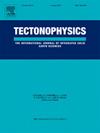Intra-salt deformation of K-Mg salt layers in diapiric structures, an analogue modelling approach
IF 2.7
3区 地球科学
Q2 GEOCHEMISTRY & GEOPHYSICS
引用次数: 0
Abstract
K-Mg salts are one to six orders of magnitude less viscous than halite and therefore flow faster than other evaporites. However, their influence and deformation patterns in diapiric structures are poorly understood. Analogue models are useful for simulating salt deformation, but have never been used to model heterogeneous salt formations involving low-viscosity K-Mg salts. We have developed a new material, designated Glime, which has a near-Newtonian behavior over the range of experimental strain rates, and a viscosity one to two orders of magnitude lower than that of the silicone putty. The Glime allowed us to simulate K-Mg salt layers interbedded with halite (represented by silicone) in analogue models of passive diapirs that were X-ray scanned. The results show that K-Mg salt absorbs more deformation than halite, forming intrasalt pillows in the early stages of diapiric growth. During diapir development, K-Mg salts are radially redistributed at the diapir apex and/or intruded by the lower salt units, leading to their verticalization along the diapir flanks. Shearing and rapid flow within verticalized K-Mg salts cause them to enlarge and form bulges at layer pinch-outs, above which vortex flows may also form. Verticalized K-Mg salts also act as shear zones promoting the rise of the lower salt layers. The results provide first-order guidelines for predicting intra-salt diapiric deformation involving K-Mg rich salts and call for further experiments to enhance our understanding. These findings are critical for anticipating the challenges of drilling within diapiric structures and optimizing the development of salt caverns for green hydrogen storage.
求助全文
约1分钟内获得全文
求助全文
来源期刊

Tectonophysics
地学-地球化学与地球物理
CiteScore
4.90
自引率
6.90%
发文量
300
审稿时长
6 months
期刊介绍:
The prime focus of Tectonophysics will be high-impact original research and reviews in the fields of kinematics, structure, composition, and dynamics of the solid arth at all scales. Tectonophysics particularly encourages submission of papers based on the integration of a multitude of geophysical, geological, geochemical, geodynamic, and geotectonic methods
 求助内容:
求助内容: 应助结果提醒方式:
应助结果提醒方式:


